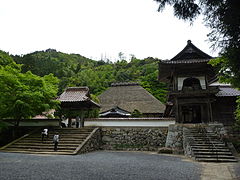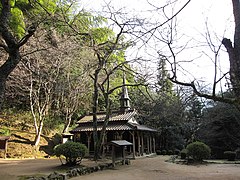Tsuwano (Shimane)
| Tsuwano-chō 津 和 野 町 |
||
|---|---|---|
| Geographical location in Japan | ||
|
|
||
| Region : | Chūgoku | |
| Prefecture : | Shimane | |
| Coordinates : | 34 ° 33 ' N , 131 ° 50' E | |
| Basic data | ||
| Surface: | 307.03 km² | |
| Residents : | 7025 (October 1, 2019) |
|
| Population density : | 23 inhabitants per km² | |
| Community key : | 32501-5 | |
| Symbols | ||
| Flag / coat of arms: | ||
| Tree : | Camphor tree | |
| Flower : | Farfugium japonicum | |
| Bird : | White heron ( great egret , Intermediate Egret , Little Egret ) | |
| town hall | ||
| Address : |
Tsuwano Town Hall 54 - 25 , Nichihara Tsuwano -chō, Kanoashi-gun Shimane 699-5292 |
|
| Website URL: | http://www.town.tsuwano.lg.jp/ | |
| Location Tsuwanos in Shimane Prefecture | ||
Tsuwano ( Japanese 津 和 野 町 , - chō ) is a small town in Kanoashi County in Shimane Prefecture , Japan . It was there that the philosopher Nishi Amane and the physician and writer Mori Ōgai , well-known through his connection to Germany, were born.
history
The former castle town of Tsuwano is located in a narrow valley on the Tsuwano River. In the east the Aono Mountain ( 青 野山 , Aono-yama ) rises at 907 m, in the west on the hill the Yoshimi built the Sambonmatsu Castle ( 三 本 松 城 , Sambonmatsu-jō ) in the Muromachi period . Later that were Ouchi , the Mori lords until then from the year 1601 Sakazaki Narimasa ( 坂崎成正 ; † 1616) from the Ukida Klan the castle Tsuwano took over. After his death in 1617 the Kamei received the castle and resided there until the Meiji restoration in 1868.
The community of Tsuwano was established on April 1, 1889 in the course of the reorganization of the Japanese community from the villages ( mura ) Tsuwano-Mori ( 津 和 野 森 村 ), Tsuwano-Ushiroda ( 津 和 野 後 田村 ), Tsuwano-Machida ( 津 和 野 町 田村 ), Tsuwano- Nakaza ( 津 和 野 中 座 村 ) and Tsuwano-Washibara ( 津 和 野 鷲 原 村 ). On October 1, 1955, parts of the villages of Hatasako, Kibe and Ogawa came. On September 25, 2005, it merged with the neighboring community of Nichihara .
Attractions

Only remnants of the wall have survived from the mountain castle, a two-story long building ( 多 聞 櫓 , tamon-yagura ), the Monomi-Bau ( 物 見 櫓 , Monomi-yagura ) of the residence below . In the residence there was a garden called Karakuen ( 嘉 楽 園 ) that has not been preserved. Today a small park nearby bears this name. In the back of this garden there is a bronze statue of the last daimyo Kamei Koremi ( 亀 井 茲 監 ; 1815–1885).
The temple Yōmei-ji ( 永明 治 ) was built in 1420 by Yoshimi Yorihiro and was the burial temple ( 菩提 寺 , bodaiji ) of the daimyō residing in Tsuwano. The temple was often ravaged by fires, the current, reed-roofed main hall (Precious Cultural Property of the Prefecture) dates from 1779. Mori Ōgai is buried there under his actual name Mori Rintarō, as is the dramaturge Nakamura Kichizō (1877-1941).
The Taikodani Inari Shrine ( 太 皷 谷 稲 成 神社 , ~ -jinja ), built in 1773, is one of the five most important shrines of the food deity Inari .
For the education of the samurai, the Kamei set up a Han school under the name Yōrōkan ( 養老 館 ). Mori Ōgai and the Nishi Amane received their first training there. Tsuwano, formerly also called "Little Kyōto" ( 小 京都 , Shō-Kyōto ), is still culturally active. So there is u in the small town. a. the museums
- Anno Art Museum ( 安 野 美術館 , Anno bijtsukan ) with works by the Tsuwano painter Anno Mitsumasa ( 安 野 * 雅 , * 1925),
- Katsushika Hokusai Museum ( 葛 飾 北 斎 美術館 , Katsushika Hokusai bijutsukan ) by a private collector with over 1000 sheets by Hokusai , including the 36 views of Mount Fuji ,
- Kuwabara-Shisei-Fotomuseum ( 桑 原 史 成 写真 美術館 , Kuwabara Shisei shashin bijutsukan ) with photos of Shisei Kuwabara (* 1936), who is known for his photographs of people with Minamata disease ,
- Morijuku Museum ( 杜 塾 ) with pictures by the Tsuwano painter Nakao Shō ( 中 尾 彰 ; 1904–1994),
- Tsuwano Local History Museum ( 津 和 野 郷 土 館 , Tsuwano kyōdokan ), founded in 1921 as the first local history museum in the prefecture. It owns the oil painting of Nishi Amane painted by Takahashi Yuichi and materials on artists and thinkers from Tsuwano, such as Ōkuni Takamasa ( 大 国 隆 正 ; 1793–1871).
Mori Ōgai and Nishi Amane are honored at the place of their parents' homes with the house Nishi Amane ( 西周 旧居 , Nishi Amane kyūkyo ) and the "Mori Ōgai memorial site" ( 盛 鴎 外 記念 館 , Mori Ōgai kinenkan ). The parents' houses of both families have been preserved and are under monument protection.
Tsuwano is also known for his heron dance ( 鷺 舞 , Sagi-mai ) at the Yasaka Shrine ( 弥 栄 神社 , Yasaka-jinja ), which is listed as an "intangible cultural asset" within the Important Cultural Assets of Japan .
The garden of the Hori family is worth seeing in the vicinity. The Hori had become rich through the nearby Sasagatani ore mine ( 笹 ヶ 谷 鉱 山 , Sasagatani kōzan ). The property dates from 1785, the garden in front of the reception rooms was completed in 1900.
There are two Christian houses of worship in Tsuwano. During the persecution of Christians in Japan , 153 Christians from Nagasaki were exiled to Tsuwano to renounce their beliefs, of which 36 refused and died as martyrs . To commemorate this, the German Jesuit missionary Paul Nebel had the Maria Chapel ( マ リ ア 聖堂 , Maria seiō ) built in 1951 as pastor for Tsuwano at the “Virgins Pass” ( 乙 女 峠 , Otome-tōge ) . Near the main train station is the 1931 Gothic-style Catholic Church Tsuwano ( 津 和 野 カ ト リ ッ ク 教会 , Tsuwano katorikku kyōkai ), which was built on the site of a previously burned down church from 1892. Every 3rd May there is also a procession for those martyrs from the church to the chapel.
traffic
The national roads 9 to Kyoto and Shimonoseki and 187 to Iwakuni and Masuda lead through the municipality . There is a connection to the rail network via the JR West Yamaguchi line to Yamaguchi and Masuda, which stop here in Tsuwano, Aonoyama, Nichihara, Aohara and Higashiaohara.
photos
Remarks
- ↑ Besides copper and zinc, a well-known product was a rat poison obtained from arsenic compounds.
literature
- Shimane no rekishi sampo henshu iinkai (Ed.): Shimane-ken no rekishi sampo. Yamakawa Shuppan, 2012. ISBN 978-4-634-24632-4 .
- Papinot, Edmond: Historical and Geographical Dictionary of Japan. Reprinted by Tuttle, 1972 edition of 1910 edition. ISBN 0-8048-0996-8 .
Web links
Individual evidence
- ↑ a b c Tsuwano: called little kyoto of "San-in". In: tsuwano-kanko.net. Tsuwano Tourist Board, accessed on July 2, 2016 .
- ↑ 乙 女 峠 に つ い て . In: 津 和 野 カ ト リ ッ ク 教会 公式 ホ ー ム ペ ー ジ (Official website of the Tsuwano Catholic Church). Retrieved July 2, 2016 (Japanese).
- ↑ 乙 女 峠 マ リ ア 聖堂 . In: tsuwano-kanko.net. Tsuwano Tourism Association, accessed July 2, 2016 (Japanese).










